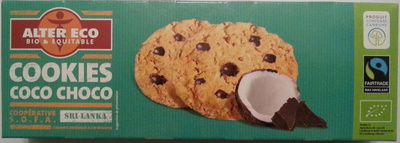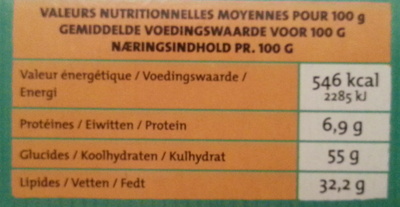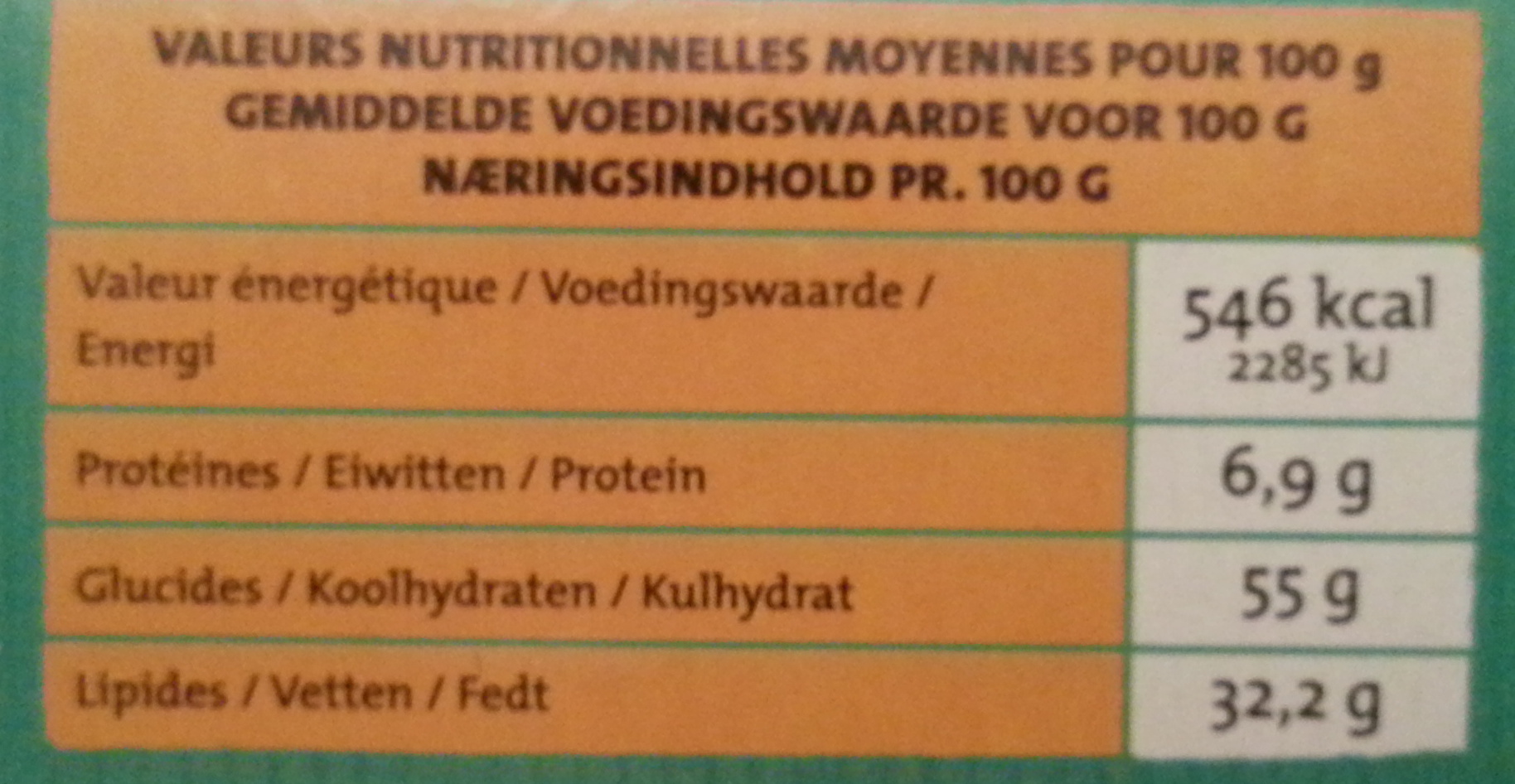Help us make food transparency the norm!
As a non-profit organization, we depend on your donations to continue informing consumers around the world about what they eat.
The food revolution starts with you!
Cookies coco choco - ALETER ECO - 150 g
Cookies coco choco - ALETER ECO - 150 g
This product page is not complete. You can help to complete it by editing it and adding more data from the photos we have, or by taking more photos using the app for Android or iPhone/iPad. Thank you!
×
Barcode: 3700214613146 (EAN / EAN-13)
Common name: Cookies à la noix de coco et aux pépites de chocolat
Quantity: 150 g
Packaging: Cardboard
Brands: ALETER ECO
Categories: Snacks, Desserts, Sweet snacks, Biscuits and cakes, Biscuits, Chocolate biscuits, Drop cookies, Chocolate chip cookies, Cookies with chocolate and coconut
Labels, certifications, awards:
Fair trade, Organic, EU Organic, Fairtrade International, Carbon compensated product, Carbon footprint, Max Havelaar, Carbon footprint


Origin of ingredients: Sri Lanka, fr:Coopérative SOFA
Traceability code: EMB 29247H - Saint-Évarzec (Finistère, France)
Countries where sold: France
Matching with your preferences
Health
Ingredients
-
20 ingredients
: Farine de blé, sucre de canne, matière grasse végétale non hydrogénée, noix de coco 15%, pépites de chocolat noir 10% (sucre, pâte de cacao, beurre de cacao, émulsifiant : lécithine de tournesol) (cacao : 50% minimum), poudres à lever : carbonate acide d'ammonium, carbonate de sodium, poudre de lait écrémé, oeufs entiers, arôme naturel, sel, acidifiant : acide citrique. * Ingrédients issus de l'agriculture biologiqueAllergens: Eggs, GlutenTraces: Nuts, Peanuts, Soybeans
Food processing
-
Ultra processed foods
Elements that indicate the product is in the 4 - Ultra processed food and drink products group:
- Additive: E322 - Lecithins
- Ingredient: Emulsifier
- Ingredient: Flavouring
Food products are classified into 4 groups according to their degree of processing:
- Unprocessed or minimally processed foods
- Processed culinary ingredients
- Processed foods
- Ultra processed foods
The determination of the group is based on the category of the product and on the ingredients it contains.
Additives
-
E322 - Lecithins
Lecithins are natural compounds commonly used in the food industry as emulsifiers and stabilizers.
Extracted from sources like soybeans and eggs, lecithins consist of phospholipids that enhance the mixing of oil and water, ensuring smooth textures in various products like chocolates, dressings, and baked goods.
They do not present any known health risks.
-
E322i - Lecithin
Lecithins are natural compounds commonly used in the food industry as emulsifiers and stabilizers.
Extracted from sources like soybeans and eggs, lecithins consist of phospholipids that enhance the mixing of oil and water, ensuring smooth textures in various products like chocolates, dressings, and baked goods.
They do not present any known health risks.
-
E330 - Citric acid
Citric acid is a natural organic acid found in citrus fruits such as lemons, oranges, and limes.
It is widely used in the food industry as a flavor enhancer, acidulant, and preservative due to its tart and refreshing taste.
Citric acid is safe for consumption when used in moderation and is considered a generally recognized as safe (GRAS) food additive by regulatory agencies worldwide.
-
E500 - Sodium carbonates
Sodium carbonates (E500) are compounds commonly used in food preparation as leavening agents, helping baked goods rise by releasing carbon dioxide when they interact with acids.
Often found in baking soda, they regulate the pH of food, preventing it from becoming too acidic or too alkaline. In the culinary world, sodium carbonates can also enhance the texture and structure of foods, such as noodles, by modifying the gluten network.
Generally recognized as safe, sodium carbonates are non-toxic when consumed in typical amounts found in food.
-
E500i - Sodium carbonate
Sodium carbonate: Sodium carbonate, Na2CO3, -also known as washing soda, soda ash and soda crystals, and in the monohydrate form as crystal carbonate- is the water-soluble sodium salt of carbonic acid. It most commonly occurs as a crystalline decahydrate, which readily effloresces to form a white powder, the monohydrate. Pure sodium carbonate is a white, odorless powder that is hygroscopic -absorbs moisture from the air-. It has a strongly alkaline taste, and forms a moderately basic solution in water. Sodium carbonate is well known domestically for its everyday use as a water softener. Historically it was extracted from the ashes of plants growing in sodium-rich soils, such as vegetation from the Middle East, kelp from Scotland and seaweed from Spain. Because the ashes of these sodium-rich plants were noticeably different from ashes of timber -used to create potash-, they became known as "soda ash". It is synthetically produced in large quantities from salt -sodium chloride- and limestone by a method known as the Solvay process. The manufacture of glass is one of the most important uses of sodium carbonate. Sodium carbonate acts as a flux for silica, lowering the melting point of the mixture to something achievable without special materials. This "soda glass" is mildly water-soluble, so some calcium carbonate is added to the melt mixture to make the glass produced insoluble. This type of glass is known as soda lime glass: "soda" for the sodium carbonate and "lime" for the calcium carbonate. Soda lime glass has been the most common form of glass for centuries. Sodium carbonate is also used as a relatively strong base in various settings. For example, it is used as a pH regulator to maintain stable alkaline conditions necessary for the action of the majority of photographic film developing agents. It acts as an alkali because when dissolved in water, it dissociates into the weak acid: carbonic acid and the strong alkali: sodium hydroxide. This gives sodium carbonate in solution the ability to attack metals such as aluminium with the release of hydrogen gas.It is a common additive in swimming pools used to raise the pH which can be lowered by chlorine tablets and other additives which contain acids. In cooking, it is sometimes used in place of sodium hydroxide for lyeing, especially with German pretzels and lye rolls. These dishes are treated with a solution of an alkaline substance to change the pH of the surface of the food and improve browning. In taxidermy, sodium carbonate added to boiling water will remove flesh from the bones of animal carcasses for trophy mounting or educational display. In chemistry, it is often used as an electrolyte. Electrolytes are usually salt-based, and sodium carbonate acts as a very good conductor in the process of electrolysis. In addition, unlike chloride ions, which form chlorine gas, carbonate ions are not corrosive to the anodes. It is also used as a primary standard for acid-base titrations because it is solid and air-stable, making it easy to weigh accurately.Source: Wikipedia
-
E503 - Ammonium carbonates
Ammonium carbonate: Ammonium carbonate is a salt with the chemical formula -NH4-2CO3. Since it readily degrades to gaseous ammonia and carbon dioxide upon heating, it is used as a leavening agent and also as smelling salt. It is also known as baker's ammonia and was a predecessor to the more modern leavening agents baking soda and baking powder. It is a component of what was formerly known as sal volatile and salt of hartshorn.Source: Wikipedia
-
E503ii - Ammonium hydrogen carbonate
Ammonium carbonate: Ammonium carbonate is a salt with the chemical formula -NH4-2CO3. Since it readily degrades to gaseous ammonia and carbon dioxide upon heating, it is used as a leavening agent and also as smelling salt. It is also known as baker's ammonia and was a predecessor to the more modern leavening agents baking soda and baking powder. It is a component of what was formerly known as sal volatile and salt of hartshorn.Source: Wikipedia
Ingredients analysis
-
May contain palm oil
Ingredients that may contain palm oil: Non-hydrogenated vegetable fats
-
Non-vegan
Non-vegan ingredients: Skimmed milk powder, Whole egg
-
Maybe vegetarian
Ingredients that may not be vegetarian: Natural flavouring
-
Details of the analysis of the ingredients
: Farine de blé, sucre de canne, matière grasse végétale non hydrogénée, noix de coco 15%, pépites de chocolat noir 10% (sucre, pâte de cacao, beurre de cacao, émulsifiant (lécithine de tournesol), cacao 5%), poudres à lever (carbonate acide d'ammonium), carbonate de sodium, poudre de lait écrémé, oeufs entiers, arôme naturel, sel, acidifiant (acide citrique)- Farine de blé -> en:wheat-flour - vegan: yes - vegetarian: yes - ciqual_proxy_food_code: 9410
- sucre de canne -> en:cane-sugar - vegan: yes - vegetarian: yes - ciqual_proxy_food_code: 31016
- matière grasse végétale non hydrogénée -> en:non-hydrogenated-vegetable-fats - vegan: yes - vegetarian: yes - from_palm_oil: maybe
- noix de coco -> en:coconut - vegan: yes - vegetarian: yes - ciqual_proxy_food_code: 15006 - percent: 15
- pépites de chocolat noir -> en:dark-chocolate-chunks - vegan: maybe - vegetarian: yes - ciqual_proxy_food_code: 31074 - percent: 10
- sucre -> en:sugar - vegan: yes - vegetarian: yes - ciqual_proxy_food_code: 31016
- pâte de cacao -> en:cocoa-paste - vegan: yes - vegetarian: yes - ciqual_proxy_food_code: 16030
- beurre de cacao -> en:cocoa-butter - vegan: yes - vegetarian: yes - ciqual_food_code: 16030
- émulsifiant -> en:emulsifier
- lécithine de tournesol -> en:sunflower-lecithin - vegan: yes - vegetarian: yes
- cacao -> en:cocoa - vegan: yes - vegetarian: yes - ciqual_proxy_food_code: 18100 - percent: 5
- poudres à lever -> en:raising-agent
- carbonate acide d'ammonium -> en:e503ii - vegan: yes - vegetarian: yes
- carbonate de sodium -> en:e500i - vegan: yes - vegetarian: yes
- poudre de lait écrémé -> en:skimmed-milk-powder - vegan: no - vegetarian: yes - ciqual_food_code: 19054
- oeufs entiers -> en:whole-egg - vegan: no - vegetarian: yes - ciqual_food_code: 22000
- arôme naturel -> en:natural-flavouring - vegan: maybe - vegetarian: maybe
- sel -> en:salt - vegan: yes - vegetarian: yes - ciqual_food_code: 11058
- acidifiant -> en:acid
- acide citrique -> en:e330 - vegan: yes - vegetarian: yes
Nutrition
-
Missing data to compute the Nutri-Score
Missing nutrition facts
⚠ ️The nutrition facts of the product must be specified in order to compute the Nutri-Score.Could you add the information needed to compute the Nutri-Score? Add nutrition facts
-
Nutrient levels
-
Fat in high quantity (32.2%)
What you need to know- A high consumption of fat, especially saturated fats, can raise cholesterol, which increases the risk of heart diseases.
Recommendation: Limit the consumption of fat and saturated fat- Choose products with lower fat and saturated fat content.
-
-
Nutrition facts
Nutrition facts As sold
for 100 g / 100 mlCompared to: Cookies with chocolate and coconut Energy 2,285 kj
(546 kcal)+6% Fat 32.2 g +7% Saturated fat ? Carbohydrates 55 g +4% Sugars ? Fiber ? Proteins 6.9 g +23% Salt ? Fruits‚ vegetables‚ nuts and rapeseed‚ walnut and olive oils (estimate from ingredients list analysis) 15 % Carbon footprint 189 g
Environment
-
Eco-Score B - Low environmental impact
⚠ ️Select a country in order to include the full impact of transportation.The Eco-Score is an experimental score that summarizes the environmental impacts of food products.→ The Eco-Score was initially developped for France and it is being extended to other European countries. The Eco-Score formula is subject to change as it is regularly improved to make it more precise and better suited to each country.Life cycle analysis
-
Average impact of products of the same category: B (Score: 65/100)
Category: Biscuit (cookie), with chocolate drops
Category: Biscuit (cookie), with chocolate drops
- PEF environmental score: 0.38 (the lower the score, the lower the impact)
- including impact on climate change: 4.22 kg CO2 eq/kg of product
Stage Impact Agriculture
49.8 %Processing
41.8 %Packaging
2.9 %Transportation
4.3 %Distribution
1.3 %Consumption
0.0 %
Bonuses and maluses
-
Labels with very high environmental benefits
Bonus: +20
-
EU Organic
Organic agriculture contributes to preserve biodiversity, climate, water quality and soil fertility.
Organic food is food produced by methods complying with the standards of organic farming and features practices that cycle resources, promote ecological balance, and conserve biodiversity.
-
Fairtrade International
Fair trade is an arrangement designed to help producers in developing countries achieve sustainable and equitable trade relationships. Members of the fair trade movement add the payment of higher prices to exporters, as well as improved social and environmental standards.
-
-
Origins of ingredients with a high impact
Malus: -5
Environmental policy: -5
Transportation: 0
Origin of the product and/or its ingredients % of ingredients Impact Sri Lanka 100 %High
-
Packaging with a low impact
Malus: -1
Shape Material Recycling Impact Unknown Cardboard Low ⚠ ️ The information about the packaging of this product is not sufficiently precise (exact shapes and materials of all components of the packaging).⚠ ️ For a more precise calculation of the Eco-Score, you can modify the product page and add them.
If you are the manufacturer of this product, you can send us the information with our free platform for producers.
Eco-Score for this product
-
Impact for this product: B (Score: 79/100)
Product: Cookies coco choco - ALETER ECO - 150 g
Life cycle analysis score: 65
Sum of bonuses and maluses: +14
Final score: 79/100
-
Carbon footprint
-
Equal to driving 2.2 km in a petrol car
422 g CO² per 100g of product
The carbon emission figure comes from ADEME's Agribalyse database, for the category: Biscuit (cookie), with chocolate drops (Source: ADEME Agribalyse Database)
Stage Impact Agriculture
27.9 %Processing
64.6 %Packaging
2.6 %Transportation
4.4 %Distribution
0.5 %Consumption
0.0 %
Packaging
-
Packaging with a low impact
-
Packaging parts
(Cardboard)
-
Packaging materials
Material % Packaging weight Packaging weight per 100 g of product Paper or cardboard
-
Transportation
-
Origins of ingredients
Origins of ingredients with a high impact
Origin of the product and/or its ingredients % of ingredients Impact Sri Lanka 100 %High
Labels
-
EU Organic
Organic agriculture contributes to preserve biodiversity, climate, water quality and soil fertility.
Organic food is food produced by methods complying with the standards of organic farming and features practices that cycle resources, promote ecological balance, and conserve biodiversity.
-
Fairtrade International
Fair trade is an arrangement designed to help producers in developing countries achieve sustainable and equitable trade relationships. Members of the fair trade movement add the payment of higher prices to exporters, as well as improved social and environmental standards.
Report a problem
-
Incomplete or incorrect information?
Category, labels, ingredients, allergens, nutritional information, photos etc.
If the information does not match the information on the packaging, please complete or correct it. Open Food Facts is a collaborative database, and every contribution is useful for all.











